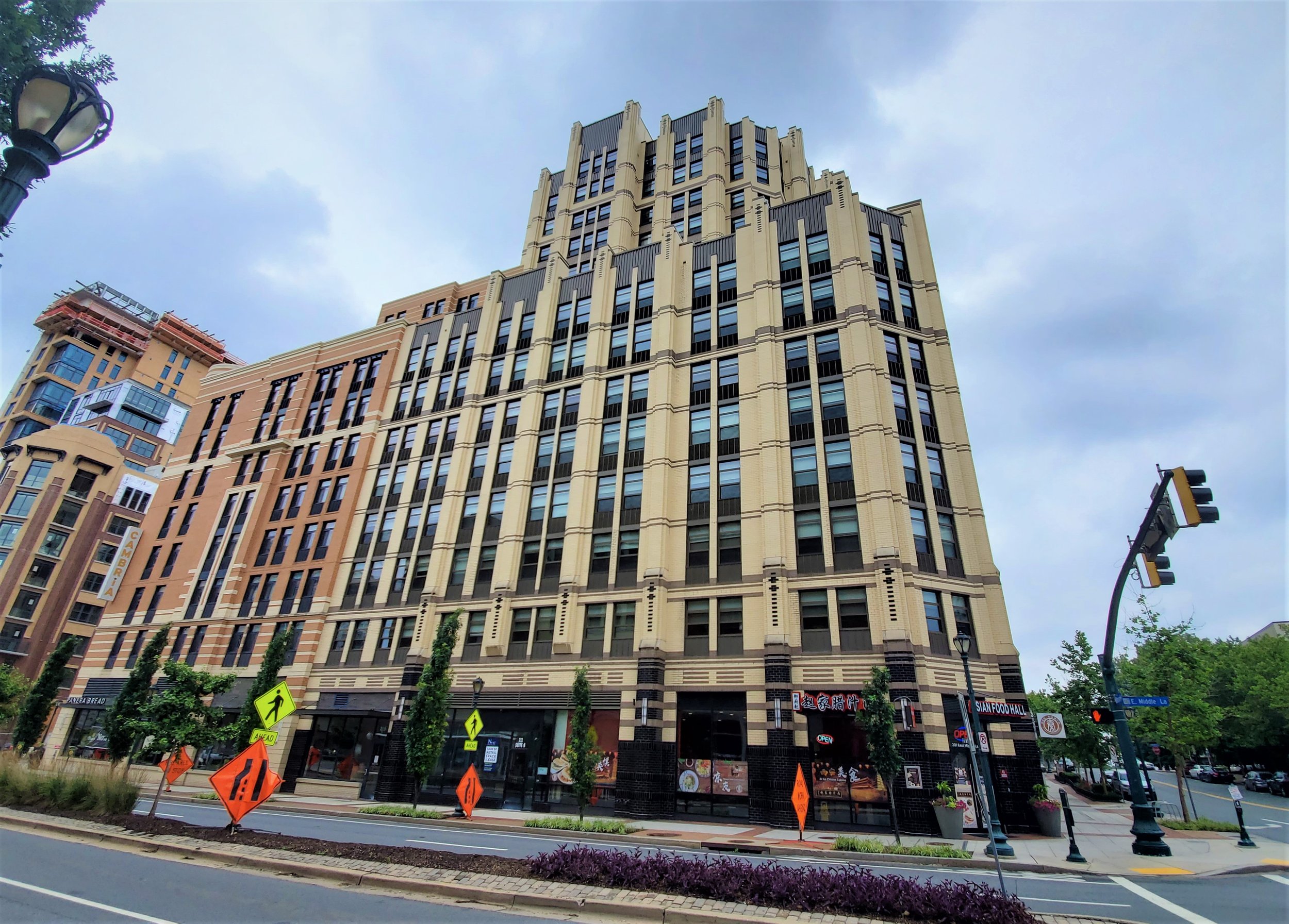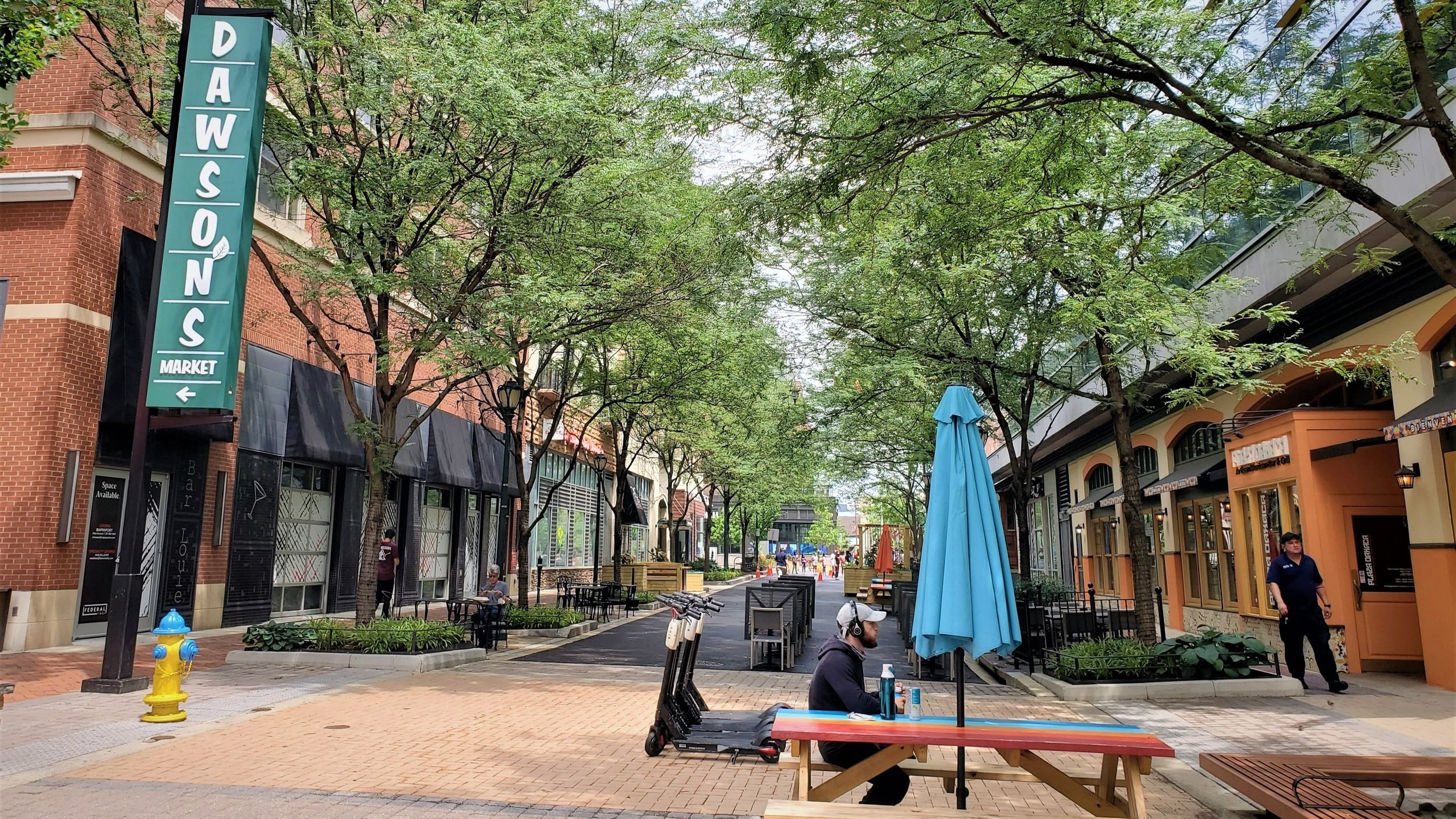A Drive Through “the Ugliest Place in Maryland”: Part 2
This is the second in a two-part photo essay on Maryland’s DC-area suburbs. You can read part one here. All images in this piece were provided by the author.
To explore Rockville Pike in transition is to move through a number of little transitions. Despite all of the pockets of new development, the highway itself, with its six alternately dangerously fast or traffic-choked lanes, still looms over the whole area. My next stop, downtown Rockville, required leaving this sanctuary and rambling down the Pike. The mental whiplash induced by this jolt between built forms probably exists beneath the surface for most people, but it is very real and rather disorienting.
Actually, there isn't much of downtown Rockville left. Most of the original urban fabric was razed decades ago. One Twitter interlocutor shared this 1949 fire insurance map of the erstwhile downtown and explained: “Most of Rockville's original downtown was demo’d for an urban renewal project back in the early-mid sixties to make way for the mall the current development replaced.” Wikipedia has a sad, instructive article on the saga, which concluded in the early 2000s with the Rockville Town Square mixed-use development, and ongoing semi-connected development in the downtown area.
A recent structure at the Rockville Town Square with art deco ornamentation.
A pedestrianized street inside the Rockville Town Square development.
Places that passed on “urban renewal” and still have their old grids and fabrics are in the best position today. But those that recognized they made a mistake are in the second-best position. We simply don’t build that way anymore, and given the realistic options that exist today, something like Rockville Town Square is not necessarily ideal; but it is good.
There’s also Pike & Rose three and a half miles down the Pike, another mixed-use mid-to-high-rise development replacing old strip plazas in an area known as North Bethesda. Developments like this get a lot of criticism. They’ve been dubbed “drive-to urbanism.” Some left-NIMBYs dislike them for being “luxury” development. Some conservatives write them off as playgrounds for single, childless people with too much money. Others simply find them cookie-cutter and aesthetically unpleasant. In other words, not family friendly, not real communities.
A classically detailed high-rise apartment building in the Pike & Rose development.
But all that misses something. Drive-to is better than drive-through, even if it isn’t ideal. The amount of detailing and design that has gone into some of the buildings is remarkable. I was here on a Friday afternoon, and there were lots of young couples and young families with kids alike. The outdoor dining tables, both those private to the many restaurants and a few public ones, were crowded.
A more modern high-rise building at Pike & Rose; the bottom portion is a hotel, and the addition at the top is a collection of condo units. Square and play area in front.
There are places where adults can sit and congregate and even have a drink while kids play nearby in the splash pool or on the fake grass, without the single-use isolation of the suburban playground. People vote with their dollars and their feet, and they were voting for this. These are more than lifestyle amenities to sneer at or to characterize as “gentrification.” They’re tangible goods for families. They enhance the texture of everyday life. Their proximity to shopping and transit—Pike & Rose, like King Farm, sits across the highway from a Metro station—make a “car-lite” arrangement realistic for many households.
On that note, one issue is going to be the maintenance and the longevity of this stuff. I spotted a number of cracked tiles at the back of one of the water features, for example, as well as a rusting water fountain.
After only a few years, about half of the tiles at the back of this fountain are cracked.
Because the entire, sprawling property is a single private development, it isn’t really possible for residents to make little fixes here and there, or even for individual business owners to do so. It’s a bit like a condo association. As Strong Towns often notes of suburban neighborhoods, everything in these large projects is built at the same time and to a finished state, meaning that maintenance comes due all at once. Will the density and productivity of these projects be enough to produce revenue for that eventual work? Will the developers remain committed to them for the medium-to-long term? Or will they age out in a few decades and face demolition and redevelopment themselves? That all remains to be seen.
The other issue, hinted at with that “drive-to” critique, is that these developments are basically islands of urbanism in a sea of highways, which have at best perfunctory infrastructure for non-motorists. Over time, however, there will be several more of these developments along Rockville Pike. One is under construction just across the street. Another has just begun, with a strip mall demolition, a couple of miles north. Eventually, there may be a fairly continuous, quasi-connected corridor of developments like this, traversable without a car and maybe even without accessing the highway.
But for now, that three-and-a-half-mile stretch between downtown Rockville and Pike & Rose is a sea of discordant, low-rise roadside development, illustrating just how isolated these pockets of urbanism are. As to the roadside architecture itself, there really isn’t much to say, except that Rockville has a higher than average number of “double-decker” strip malls, an interesting commercial form that is rare in the United States.
One of several two-story strip malls along Rockville Pike.
One such two-story plaza is identified on Montgomery County’s interactive map system as being from 1990 (though the buildings next door are from 20 years earlier, suggesting it may have existed in some form before that.) Another, larger one, dating to 1964, is a reminder that this part of Maryland has been deeply settled, and fairly dense, for a long time—why else would such a land-efficient building type have been utilized that long ago?
Rockville is not an exurb; it is a former streetcar suburb to Washington, DC. The area’s new and rising apartment buildings and mixed-use projects are not out of place, even if they are a little bit out of scale. Far from an imposition or redefinition, they’re a sensible step up in the intensity of the area’s land use. The people who built the first or second generations of buildings along here would never have expected that landscape to remain encased in regulatory amber as long as it has been. They would have understood—they did understand—that dynamism, flexibility, resiliency, and change are all one package.
Consider this tidbit from a profile of Rockville’s trolley era: “In 1929, W&R [Washington & Rockville Electric Railway Company] ran 24 trips a day between 6:30 a.m. and 12:30 a.m. to connect Rockville and Washington.” It is almost as if places like this are awakening from a long slumber under the interlocking forces of suburban land use and car dependency, and picking up where they left off in the early 20th century. It is change, to be sure, but it is also a kind of continuity.
The building blocks for an urban transformation, then, are here. Certainly, more than they were a couple of decades ago. But that highway. Dan Reed, a planner and urbanist based in Maryland, wrote of a proposal to widen the highway even further: “The resulting road will be so wide and complex that Usain Bolt would have trouble getting across before the light changes.”
That proposal included a bus-rapid-transit lane, such that that the highway would not be entirely car-centric. But it would still bisect the two sides of Rockville Pike, acting not as a main street to stitch together its increasingly urban surroundings, but rather as a barrier between them. With any luck, the highway can be calmed—even narrowed. There’s still I-270, after all.
Even when Rockville’s transformation from low-rise sprawl to mixed-use urbanism is complete, it will still retain its fundamental suburban character. This is not about turning suburbs into cities, but rather about lifting the barriers that have frozen suburban land use in time. It is about unleashing creative and entrepreneurial energy—and allowing them to evolve into something familiar, yet new.
Addison Del Mastro writes on urbanism and cultural history. He tweets at @ad_mastro and writes daily at Substack.










Varsha Gopal is an architect from Chennai, India. She joins Norm today to discuss discuss two research projects she recently conducted in her city and what they taught her about thriving cities, urban design and community engagement. (Transcript included.)